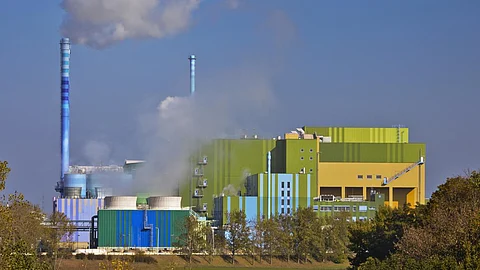
- Topics
- Feature
- Opportunities & Events
- About
- Hindi Portal
- Data
- Topics
- Feature
- Opportunities & Events
- About
- Hindi Portal
- Data

With the ever-increasing demand for energy in a rapidly growing economy like India, cheap and sustainable energy is the need of the hour. Waste-to-energy conversion remains a major untapped energy resource in the Indian context. Waste-to-energy conversion using municipal solid wastes is gaining importance due to (a) the shortage of lands that can be utilized as landfills and the rate at which waste-to-energy techniques decrease the volume of waste, (b) it helps to minimize the impact on the environment, and (c) it can be used for generating both electricity and heat as well as to provide a financial incentive by recovery of valuable components like metals, plastics, and other recyclable solid wastes which can be segregated.
There are several challenges and barriers that India must overcome while dealing with waste-to-energy technologies. Some of the major concerns include uncertain policies, socio-economic and financial challenges, profitability, and sustainability as compared to non-renewable resources.
Another major concern and cause for resentment among the general population for waste-to-energy technologies are related to their toxic pollutant emissions like dioxins/furans, polycyclic aromatic hydrocarbons (PAHs), etc. These hazardous pollutants become a part of the flue gases coming out of waste to energy plants as well as the solid residue which is dumped at the landfill sites.
Several efforts have been made by the government of India to improve our waste energy potential (biomass, municipal solid waste). A significant improvement in biomass energy generation capacity (10 GW) has been attained in the past decade, however, the municipal solid waste-based energy potential is yet to be realized. It is to be mentioned that less than 5% of the overall energy generation potential from municipal solid waste is currently utilized in India.
The paper by Arijeet Karmakar et al ‘A comprehensive insight into Waste to Energy conversion strategies in India and its associated air pollution hazard’ in the journal ‘Environmental Technology & Innovation’ has reviewed currently available technologies relevant to the Indian waste-to-energy sector, and their advantages and limitations. The review also provides information on installed electricity generation capacity from waste to energy in different parts of India and sheds light on the overall energy potential.
The study highlights the differences between the global and the Indian waste-to-energy scenario. European cities give great importance to solid waste management and waste-to-energy conversion technology. The European wastes have lower moisture content (about 20% to 30%) as compared to Indian municipal solid wastes (about 40% to 50%). This is a major factor in why waste incineration plants in India incur heavy financial losses in many cases.
It has been recorded that the average municipal solid waste generation per capita decreased in European countries from 520 kg/capita in the year 2008 to approximately 475 kg/capita in 2012. According to the terms of directives of the Austrian landfill, it was prohibited to dump into the landfill any wastes which have more than 5% of organic carbon content without prior treatment. This is in absolute contrast to the Indian scenario, where most of the states treat less than 10% of the total waste collected.
It has been found in many European countries that a major portion of waste management is performed using landfilling. However, some countries like Germany, Netherlands, Belgium, Sweden, Denmark, and Austria have maintained landfill at less than 5%.
The situation in Delhi is exactly the opposite compared to those of European cities where most waste goes into landfill sites. As the Indian population and per capita waste generation grow in the next few decades, landfill sites will be entirely exhausted and the need for alternative waste management strategies will gain impetus. Therefore, waste-to-energy plants based on different thermochemical & biochemical technology will become an integral part of urban and rural infrastructure.
The European Union has advanced technologies for waste-to-energy conversions and at the same time, it has one of the highest recycling rates in the world. European Union gives a higher preference to reuse and recycling over other treatment options. Then comes composting, incineration, and finally if there is no other option then landfilling is done. The European Union’s waste framework directive (which is the current legislation), aims at achieving a 50% recycling or processing by reuse target by the end of 2020.
The study devotes significant attention to identifying and suggesting mitigation strategies for air pollution hazards of waste to energy plants. The review also includes a discussion on environmental impact assessments of waste-to-energy technologies.
In this paper, the key factors which are needed to be considered while building/planning a waste-to-energy plant have been reviewed and the best plant options have been suggested in various scenarios based on cost-effectiveness and environmental friendliness. Several challenges and roadblocks preventing the successful implementation of several Indian waste-to-energy projects have been presented.
Biochemical-based (anaerobic digestion and fermentation) and thermo-chemical waste-to-energy methods (gasification/pyrolysis) are the most suitable techniques considering the physical and chemical properties of Indian solid waste as it contains a large percentage of biodegradable, wet, and organic waste.
Air pollutants from waste to energy plants have significant health and toxicological effects on humans. Several illnesses like respiratory, cardiovascular, cancer, skin–nose irritation and kidney–liver–brain damage are caused by these air pollutants.
This review article helps to highlight the different factors critical to the success of Indian waste-to-energy projects. Despite several challenges and health-related concerns associated with waste-to-energy plants in India, the authors reiterate the importance of such projects both in terms of energy security and effective solid waste management.
The full paper can be accessed here